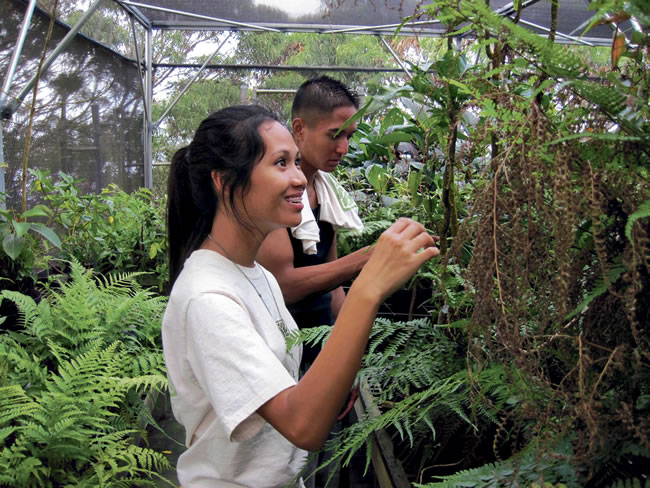Institute Helps Teens Go Green

Sharmaine Aquino and Marc Agnir observe rare plants at a specialized nursery. Photo from Pauline Sato.
During fall break earlier this month, 16 students from Kapolei, Waianae, Mililani and Nanakuli high schools opted to spend their vacation learning about environmental issues and solutions.
They signed up for the Hawaii Green Collar Institute’s weeklong course that focused on watersheds, streams and the ocean.
Exploring the Mokuleia Forest Reserve and the Pahole Natural Area Reserve, the students engaged in a number of projects, including removing invasive plants and predatory snails from the area. They also removed hundreds of pounds of trash that had been dumped along the coastline.
In addition to these hands-on projects, the group met with environmental professionals and visited Leeward Community College to learn about related programs.
“The overall goal is to encourage students, especially in West Oahu and the Leeward Coast, to love their environment, learn about it, and to know how to solve problems that are out there,” Malama Learning Center executive and program director Pauline Sato said of the institute.
Formed in 2010 in conjunction with the Kapolei High-based Malama Learning Center and Leeward Community College, the Green Collar Institute offers various programs targeted at different ages and audiences, including high school students, college students and teachers.
Each session highlights a different topic under the umbrella of environmental education.
Fall break may be over, but the students’ work continues. Currently, each participant is working individually on a project of their choice related to their experience. For example, Kapolei High sophomore Marc Agnir will educate others about invasive species by conducting hikes and making an informational a video.
Green careers related to the session’s water theme could include watershed protection, marine biology, wastewater management and wetland conservation.
Sato said that while not all of the students will become green professionals, she hopes that each of them will find a way to incorporate the knowledge into their lives – and that they will share what they’ve learned with others.
Future institute themes could include agriculture and alternative energy.
“We have just scratched the surface with what we could expose students to,” Sato added. “We could do so much more and go deeper. I think the opportunities to continue to grow and expand the program are pretty numerous.
“The people who we are working with can be the people who make the solutions happen. But they need to be given that opportunity.”





